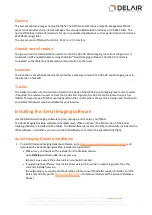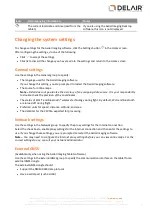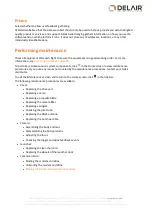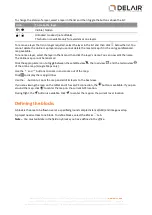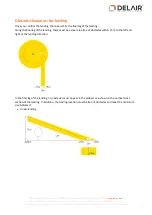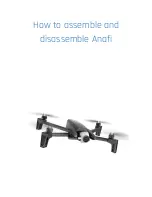
For more information, see
Exporting flight data for processing, page 100
.
When using a lens for the first time on a specific camera body, you must carefully assemble the camera and
adjust the camera focus. For more information, refer to the maintenance procedures for the camera in the
Maintenance
screen.
Selecting the operating mode
Select one of the following operating modes:
l
: For centimeter-level
absolute
accuracy
l
: For high
relative
precision
PPK
If you need centimeter-level accuracy, select PPK for the operating mode.
Coordinates
X, Y
Z
Absolute accuracy*
Down to 2.2 cm (0.88 ")
Down to 2.0 cm (0.79 ")
Relative accuracy*
1–2 x GSD
* According to American Society for Photogrammetry and Remote Sensing (ASPRS) standards (aerial triangulation accuracy).
Note –
The absolute accuracy depends on the accuracy of the reference station and the distance between
that station and the rover (typically called the baseline length). The shorter the distance, the more
accurate the results will be.
PPK requires data from a reference station. This station can be a local base station that you set up before
the flight or a network reference station, such as CORS, that you access after the flight.
Local base station
A local base station is a GPS receiver located at a known fixed location or at a location with unknown
coordinates. If the coordinates are unknown, then the local base station must be used with data from a
reference network, such as the CORS network. For more information, see
Network of reference stations,
To set up the base station, follow the instructions provided by the base station user guide.
Note –
It is the user’s responsibility to make sure that the base station is set up correctly.
The base station should be located within 5 km (3.1 miles) of the area to map: the closer, the better. Line-of-
sight (visibility) is not required between the base and the rover. The exact location of the base station
should be measured in the coordinate system you will use in the postprocessing software.
The base station should have a clear and unobstructed view of the sky. Be aware of likely multipath sources
such as buildings, wire fences, high voltage power sources, and trees.
The rover receiver logs GNSS data at 20 Hz. Delair recommends having a base receiver that logs the GNSS
data as frequently as the logging interval used by the rover receiver.
Note –
Using a slower logging rate will affect the accuracy.
Network of reference stations
A network of reference stations, such as a CORS or VRS network, is a network of base stations at a known
fixed location. Each base station continuously collects and records GNSS observation data. Many reference
networks exist over the world, some of them denser than others. The reference data from a network
reference station is accessible via the Internet.
22
Delair-Tech
|
676, Rue Max Planck – 31670 Toulouse-Labège, France
|
Tel: +33 (0) 5 82 95 44 06
|
Capital: 238 110,30 € - APE: 3030Z – Intra-Community VAT number: FR90 53 09 69 781 – 530 969 781 R.C.S. Toulouse
This document is the sole property of Delair-Tech and cannot be used or reproduced without the written authorization of Delair-Tech
.



